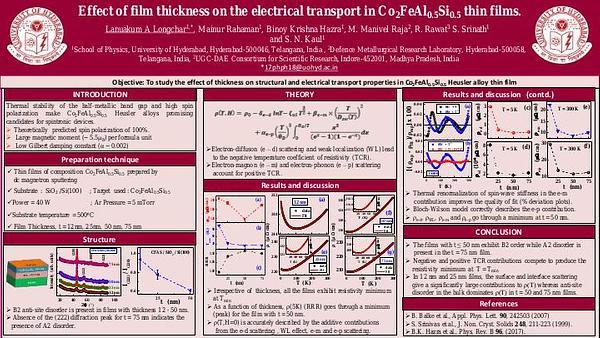Would you like to see your presentation here, made available to a global audience of researchers?
Add your own presentation or have us affordably record your next conference.
Spin torque nano-oscillators are spintronic devices in which radiofrequency magnetization oscillations can be generated through spin-transfer effects. Due to their
nonlinearity, these devices display interesting properties such as frequency stability and high tunability, opening up possibilities from wireless telecommunication to neuromorphic
computing 1.
In this study, we will focus on vortex-based spin-torque nano-oscillators (STVO) and study the response of mutually coupled STVOs. To couple them, we use the RF current emitted by
one STVO, which is first amplified and then sent through the antenna located above the second STVO and vice versa. The resulting external RF field hence mediates the coupling between
the two STVOs.
Using this approach, beyond the expected improvement of their RF properties, i.e., power emission and spectral purity 2, we have recently shown that strong coupling can lead to new
phenomena beyond synchronization, such as amplitude death, mode branching, and non-trivial states associated with exceptional points (EPs) 3. EPs, defined as singularities of nonHermitian problems, can indeed emerge from such systems. Combining experimental results (Fig.1) and theoretical modeling (Fig.2), we succeed in demonstrating that the presence of
mode branching (see Fig.1) can be connected to the coalescence of the system complex eigenvalues, i.e., the existence of an EP, in a specific current range.
The next step is to investigate, both in frequency and time domain, how these EPs' existence is sensitive to the individual properties of each STVO and the path used to approach this EP
state 4. We believe that this study opens spintronic devices to the field of non-Hermitian Hamiltonian physics, already observed in several variable loss/gain systems in photonics and
electronics 5. By proving the engineering of EPs for high sensitivity mode control, the objective will be to show the potential of this technique in sensor-type systems.
References
1 N. Locatelli, V. Cros, and J. Grollier, Nature Materials, 13, 1, 11 (2016)
2 R. Lebrun, et al., Nat. Comm. 8, 15825 (2017)
3 S. Wittrock, et al., arXiv:2108.04804 (2021)
4 C. Dembowski et al., Phys. Rev. Lett. 86, 787 (2001)
5 Z. Liu, et al., arXiv:2009.07713 (2020)

Fig.1 Frequency spectra of the coupled STVOs versus STVO2 current IDC,2 and fixed IDC,1. An EP is observed at (I1,I2) = (8,8) mA.

Fig.2 Corresponding complex eigenvalues versus STVO2 current IDC,2. Eigenvalues are in dashed (uncoupled) and solid (coupled) lines.
